Submitted:
03 November 2023
Posted:
07 November 2023
You are already at the latest version
Abstract

Keywords:
1. Introduction
2. Geology of the Kola rare-metal pegmatite belt
3. Methods and sampling
4. Results and Discussion
4.1. Zoning in CGM and included minerals
4.1.1. Kolmozero deposit
4.1.2. Polmostundra deposit
4.1.3. Okhmylk deposit
4.1.4. Shongui deposit
4.2. Mineral chemistry of CGM
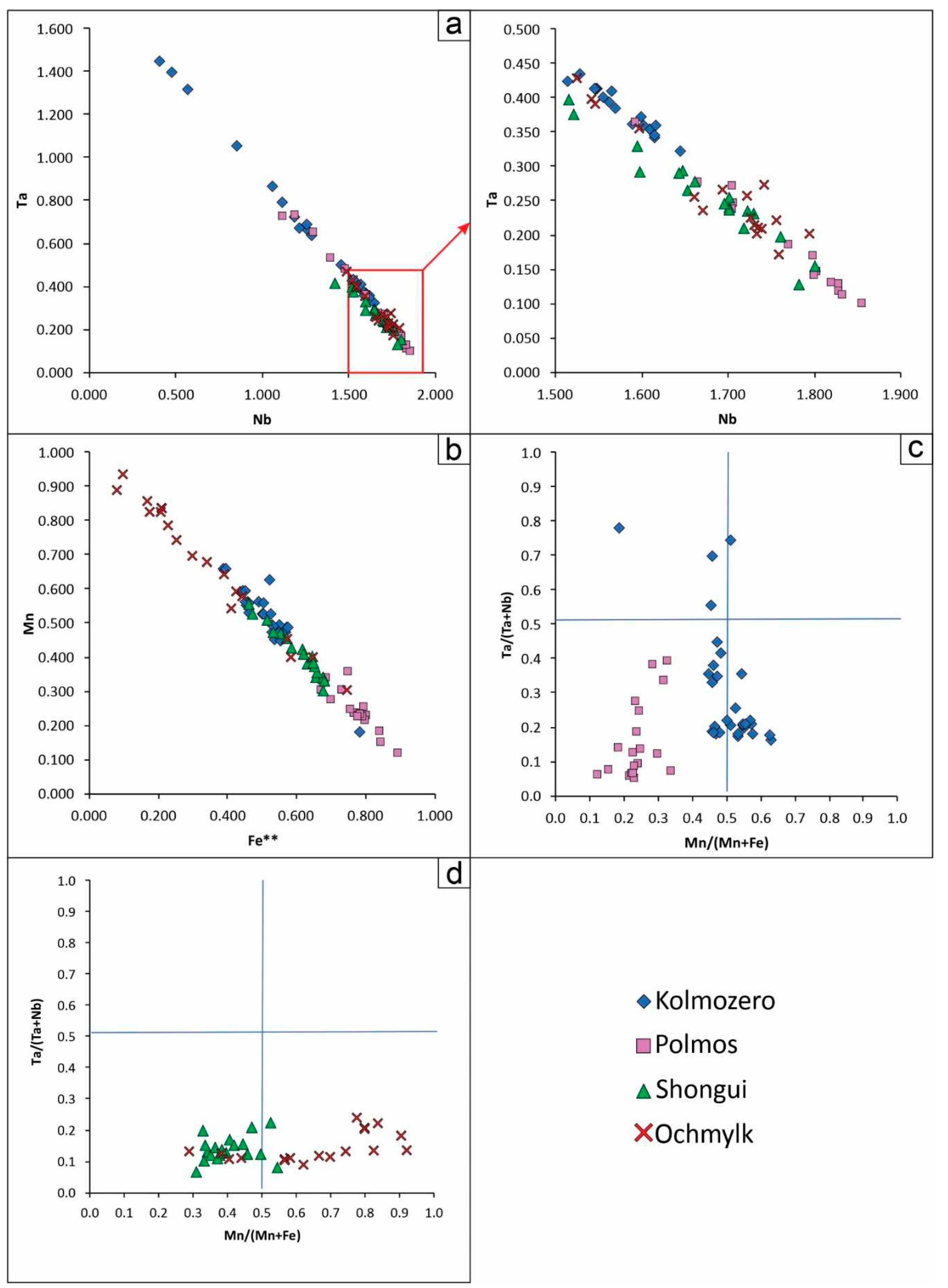
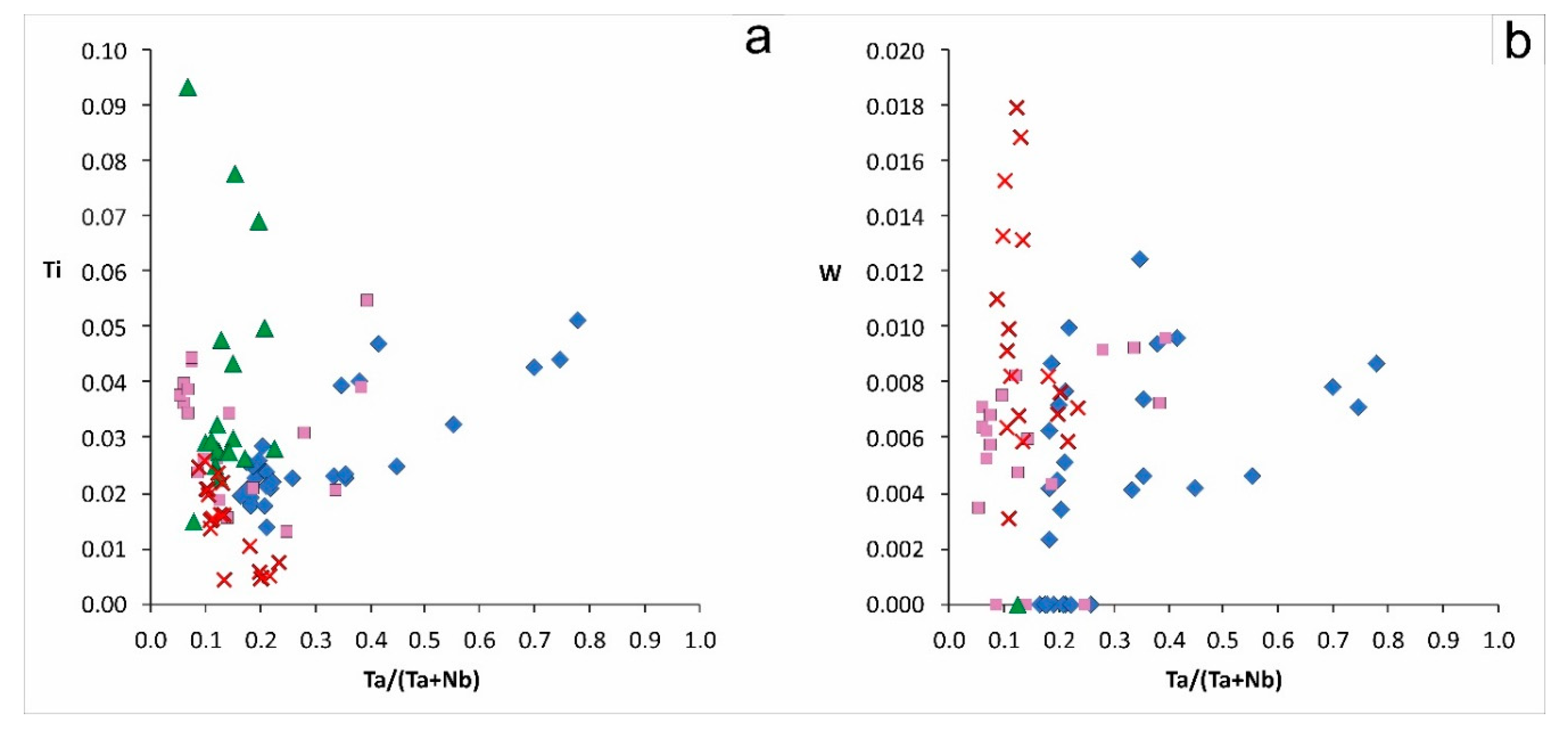
4.2.1. Kolmozero deposit
4.2.2. Polmostundra deposit
4.2.3. Okhmylk deposit
4.2.4. Shongui deposit
4.3. Associated pyrochlore supergroup minerals and cassiterite
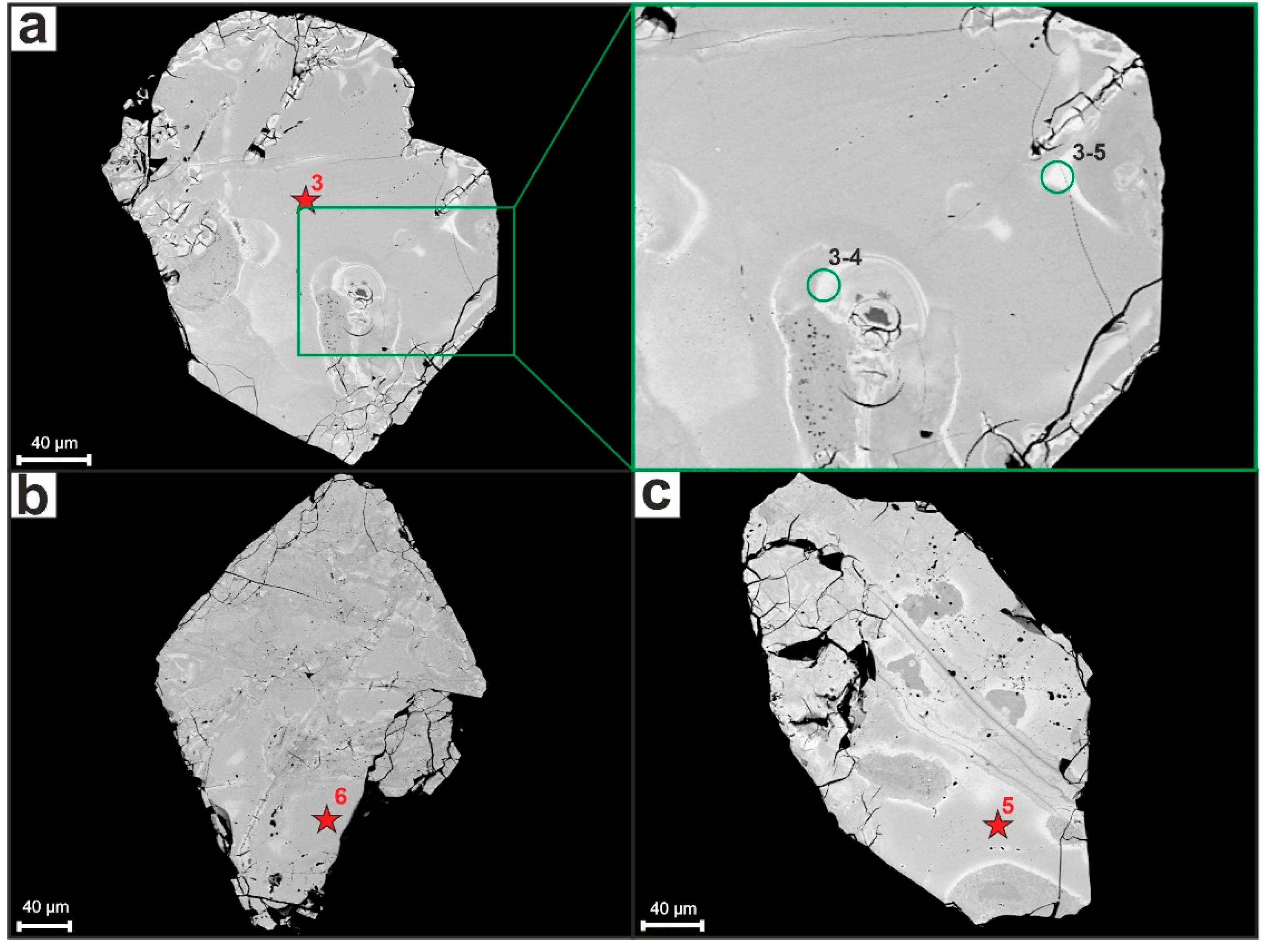
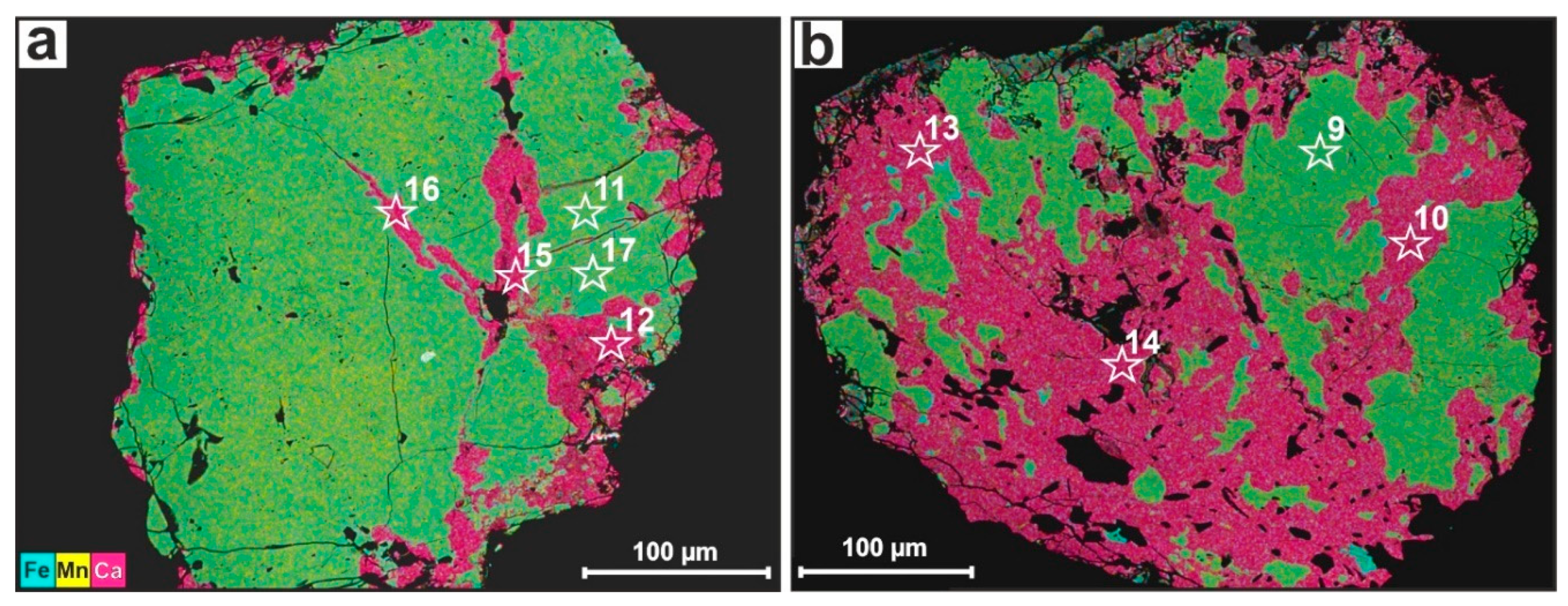
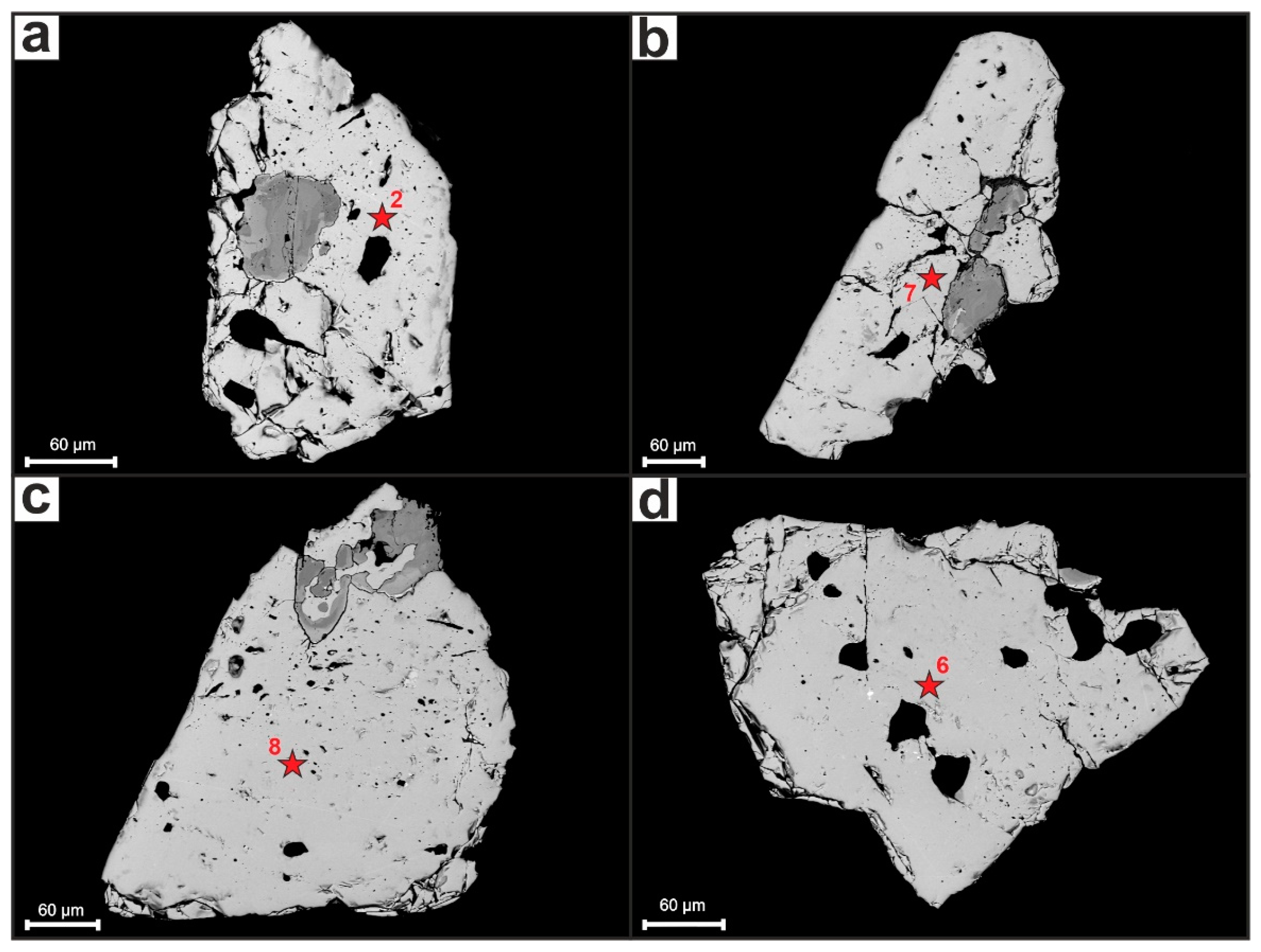
4.4. Implication for ore genesis and grade
5. Conclusions
- CGM from high-grade Li pegmatite deposits from the Kolmozero-Voronja belt are characterized by several mineral species showing large variations in chemical compositions, mainly controlled by Nb-Ta fractionation. Textural patterns are extremely various and indicate the involvement of numerous magmatic and hydrothermal processes.
- Nb-Ta magmatic fractionation in CGM from low-grade and barren pegmatite deposits is insignificant.
- Fe-Mn fractionation is mainly controlled by precipitation of certain Fe minerals during pegmatite formation and does not play an important role in the grade of the deposits.
- PSGM from high- to medium-grade lithium deposits are magmatic (Nb varieties) and early hydrothermal (Ta varieties), while in low-grade to barren pegmatites the mineral crystallized at late hydrothermal stages (both Nb and Ta varieties). PSGM from beryllium deposits are early magmatic Ta varieties and crystallized before CGM.
- Sn is concentrated in CGM from high- to medium-grade Li pegmatites, while it formed abundant hydrothermal cassiterite in low-grade and barren pegmatites.
- Be-Ta pegmatites from the Kolmozero-Voronja belt are characterized by CGM with lowest variations of fractionation ratios Ta/(Ta + Nb) and Mn/(Mn + Fe) and highest Ti contents.
Supplementary Materials
Acknowledgments
References
- Černý, P.; Ercit, T.S. Some recent advances in the mineralogy and geochemistry of Nb and Ta in rare-element granitic pegmatites. Bulletinof Mineralogy 1985, 108, 499–532. [Google Scholar] [CrossRef]
- Černý, P.; Ercit, T.S. Mineralogy of niobium and tantalum: crystal chemical relationships., paragenetic aspects and their economic implications. In: Moller, P., Cerny, P., Saupe, F. (Eds.), Lanthanides, Tantalum and Niobium. Springer Verlag, Heidelberg, 1989; pp. 27–79.
- Raimbault, L. Composition of complex lepidolite-type granitic pegmatites and of constituent columbite-tantalite, Chedeville, Massif Central, France. The Canadian Mineralogist 1998, 36, 563–583. [Google Scholar]
- Uher, P.; Černý, P.; Chapman, R.; Hatar, J.; Miko, O. Evolution of NbTa-oxide minerals in the Prasiva granitic pegmatites, Slovakia; I, Primary Fe, Ti-rich assemblage. The Canadian Mineralogist 1998, 36, 525–534. [Google Scholar]
- Lumpkin, G.R. Composition and Structural State of Columbite - Tantalite from the Harding Pegmatite, Taos Countv,New Mexico. The Canadian Mineralogist 1998, 36, 585–599. [Google Scholar]
- Novák, M.; Uher, P.; Černý, P.; Siman, P. Compositional variations in ferrotapiolite+tantalite pairs from the beryl-columbite pegmatite at Moravany nad Váhom, Slovakia. Mineralogy and Petrology 2000, 69, 295—306. [Google Scholar]
- Beurlen, H.; Da Silva, M.R.R.; Thomas, R.; Soares, D.R.; Olivier, P. Nb-Ta-(Ti-Sn) oxide mineral chemistry as tracer of rare-element granitic pegmatite fractionation in the Borborema Province, Northeastern Brazil. Mineral Deposits 2008, 43, 207–228. [Google Scholar] [CrossRef]
- Badanina, E.V.; Sitnikova, M.A.; Gordienko, V.V.; Melcher, F.; Gäbler, H.E.; Lodziak, J.; Syritso, L.F. Mineral chemistry of columbite-tantalite fromspodumene pegmatites of Kolmozero, Kola Peninsula (Russia). Ore Geology Reviews 2015, 64, 720–735 [CrossRef]. [Google Scholar] [CrossRef]
- Zhou, Q.; Qin, K.; Tang, D. Mineralogy of columbite-group minerals from the rare-element pegmatite dykes in the East-Qinling orogen, central China: Implications for formation times and ore genesis. Journal of Asian Earth Sciences 2021, 218, 104879. [Google Scholar] [CrossRef]
- Zhang, A.C.; Wang, R.C.; Hu, H.; Zhang, H.; Zhu, J.C.; Chen, X.M. Chemical evolution of Nb-Ta oxides and zircon from the Koktokay No3 granitic pegmatite, Altai, northwestern China. Mineralogical Magazine 2004, 68, 739–756. [Google Scholar] [CrossRef]
- van Lichtervelde, M.; Salvi, S.; Beziat, D.; Linnen, R.L. Textural features and chemical evolution in tantalum oxides: Magmatic versus hydrothermal origins for Ta mineralization in the Tanco Lower Pegmatite, Manitoba. Canada. Economic Geology 2007, 102, 257–276. [Google Scholar] [CrossRef]
- Llorens, T.; Moro, M.C. Microlite and Tantalite in the LCT Granitic Pegmatites of La Canalita, Navasfrías Sn–W District, Salamanca, Spain. The Canadian Mineralogist 2010, 48, 375–390. [Google Scholar] [CrossRef]
- Martins, T.; Lima, A.; Simmons, W.B.; Falster, A.U.; Noronha, F. Geochemical fractionation of Nb-Ta oxides in Li-bearing pegmatites from the Barroso-Alvão pegmatite field, northern Portugal. The Canadian Mineralogist 2011, 49, 777–791. [Google Scholar] [CrossRef]
- Melcher, F.; Graupner, T.; Gäbler, H.-E.; Sitnikova, M.; Henjes-Kunst, F.; Oberthür, T.; Gerdes, A.; Dewaele, S. Tantalum–(niobium–tin) mineralisation in African pegmatites and rare metal granites: Constraints from Ta–Nb oxide mineralogy, geochemistry and U–Pb geochronology. Ore Geology Reviews 2015, 64, 667–719. [Google Scholar] [CrossRef]
- Melcher, F.; Graupner, T.; Gäbler, H.-E.; Sitnikova, M.; Oberthür, T.; Gerdes, A.; Badanina, E.; Chudy, T. Mineralogical and chemical evolution of tantalum–(niobium–tin) mineralisation in pegmatites and granites. Part 2: Worldwide examples (excluding Africa) and an overview of global metallogenetic patterns. Ore Geology Reviews 2017, 89, 946–987. [Google Scholar] [CrossRef]
- González, T.L.; Polonio, F.G.; Moro, F.J.L.; Fernández, A.F.; Contreras, J.L.S.; Benito, M.C.M. Tin-tantalum-niobium mineralization in the Penouta deposit (NW Spain): Textural features and mineral chemistry to unravel the genesis and evolution of cassiterite and columbite group minerals in a peraluminous system. Ore Geology Reviews 2017, 81, 79–95. [Google Scholar] [CrossRef]
- Sun, W.; Zhao, Z.; Mo, X.; Wei, C.; Dong, G.; Li, X.; Yuan, W.; Wang, T.; Yang, S.; Wang, B.; Pan, T.; Han, J.; Cao, H.; Tang, Y.; Zhang, L. Age and Composition of Columbite-Tantalite Group Minerals in the Spodumene Pegmatite from the Chakabeishan Deposit, Northern Tibetan Plateau and Their Implications. Minerals 2023, 13, 201. [Google Scholar] [CrossRef]
- Černý, P. Characteristics of pegmatite deposits of tantalum. In: Möller, P., Černý, P., Saupé, F. (Eds.), Lanthanides, Tantalum and Niobium. Springer-Verlag, Berlin, 1989; pp. 195-239.
- Spilde, M.N.; Shearer, C.K. A comparison of tantalum - niobium oxide assemblages in two mineralogically distinct rare-element granitic pegmatites, Black Hills, South Dakota. The Canadian Mineralogist 1992, 30, 719–737. [Google Scholar]
- Černý, P.; Němec, D. Pristine vs. contaminated trends in Nb,Ta-oxide minerals of the Jihlava pegmatite district, Czech Republic. Mineralogy and Petrology 1995, 55, 117–129. [Google Scholar] [CrossRef]
- Linnen, R.L.; van Lichtervelde, M.; Černý, P. Granitic pegmatites as sources of strategic metals. Elements 2012, 8, 275–280. [Google Scholar] [CrossRef]
- Multimedia reference book on mineral resources and the mining complex of the Murmansk region: a digital information resource, 2001. Mitrofanov F.P., Lebedev A.V. (Eds), GI KSC RAS, Apatity.
- Mints, M.V.; Dokukina, K.A.; Filippova, I.B.; Konilov, A.N. East European Craton: Early Precambrian History and 3D Models of the Deep Structure of the Earth’s Crust. Geological Society of America (GSA), Boulder, Colorado, 2015; 433 pp.
- Daly, J.S.; Balagansky, V.V.; Timmerman, M.J.; Whitehouse, M.J. The Lapland-Kola Orogen: Palaeoproterozoic collision and accretion of the northern Fennoscandian lithosphere. In: Gee D.G., Stephenson R.A. (Eds), European Lithosphere Dynamics, Memoir 32. Geological Society, London, 2006; pp. 579‒597.
- Belolipetsky, A.P.; Gaskelberg, V.G.; Gaskelberg, L.A.; Antonyuk, E.S.; Ilyin, Y.I. Geology and geochemistry of metamorphic complexes of the Early Precambrian of the Kola Peninsula. L.: Science, 1980, 240 pp.
- Vrevsky, A.B. Petrology and geodynamic modes of development of the Archean lithosphere (on the example of the northeastern part of the Baltic Shield). L.: Science, 1989, 143 pp.
- Glebovitsky, V.A. Early Precambrian of the Baltic Shield, 2005. Science, St. Petersburg, 711 pp.
- Hölttä, P.; Balagansky, V.; Garde, A.A.; Mertanen, S.; Peltonen, P.; Slabunov, A.; Sorjonen-Ward, P.; Whitehouse, M. Archean of Greenland and Fennoscandia. Episodes 2008, 31, 13–19. [Google Scholar] [CrossRef]
- McCaffrey, K.J.W.; Lonergan, L.; Wilkinson, J.J. Fractures. Fluid Flow and Mineralization. Geological Society of London. London, 337 pp.
- Morozova, L.N. Kolmozero lithium deposit of rare metal pegmatites: new data on rare element composition (Kola Peninsula). Lithosphere 2018, 18, 82–98. [Google Scholar] [CrossRef]
- Morozova, L.N.; Bazai, A.V. Spodumene from rare-metal pegmatites of the Kolmozerskoe lithium deposit (Kola Peninsula). Proceedings of the Russian Mineralogical Society 2019, 148 (1), 65–78.
- Morozova, L.N.; Sokolova, E.N.; Smirnov, S.Z.; Balagansky, V.V.; Bazai, A.V. Spodumene from rare-metal pegmatites of the Kolmozero lithium world-class deposit on the Fennoscandian shield: trace elements and crystal-rich fluid inclusions. Mineralogical Magazine 2021, 85 (2), №557, 149-160.
- Zozulya, D.; Macdonald, R.; Bagiński, B. REE fractionation during crystallization and alteration of fergusonite-(Y) from Zr-REE-Nb-rich late- to post-magmatic products of the Keivy alkali granite complex, NW Russia. Ore Geology Reviews 2020, 125, 103693. [Google Scholar] [CrossRef]
- Gordienko, V. V. Mineralogy, geochemistry and genesis of spodumene pegmatites. L.: Nedra, 1970; 239 pp.
- Morozova, L.N.; Bayanova, T.B.; Bazai, A.V.; Lyalina, L.M.; Serov, P.A.; Borisenko, E.S.; Kunakkuzin, E.L. Rare-metal pegmatites of the Kolmozerskoe lithium deposit in the Arctic region of the Baltic Shield: new geochronological data. Bulletin of the Kola Science Center of the Russian Academy of Sciences, (in Rusian). 2017, 1, 43–52. [Google Scholar]
- Hanski, E.J.; Melezhik, V.A. Litho- and chronostratigraphy of the Palaeoproterozoic Karelian formations. In: Melezhik V.A. (Ed), Reading the Archive of Earth’s Oxygenation, v. 2. Springer, Berlin, 2013; pp.
- Kudryashov, N.M.; Udoratina, O.V.; Kalinin, A.A.; Lyalina, L.M.; Selivanova, E.A.; Grove, M.J. U-Pb (SHRIMP-RG) age of zircon from rare-metal (Li, Cs) pegmatites of the Okhmylk deposit of the Kolmozero-Voron’ya greenstone belt (northeast of the Fennoscandian shield). Journal of Mining Institute 2022, 255, 448–454. [Google Scholar] [CrossRef]
- Antonyuk, E.S. Structural-mineral complexes of granite pegmatite veins, Materials on the mineralogy of the Kola Peninsula. KFAN USSR, Apatity, 1962; pp. 134-142.
- Polkanov, A.A.; Gerling, E.K. Geochronology and geological evolution of the Baltic Shield and its folded framing. Trudy LAGED (in Rusian). 1961, 12, 101–102. [Google Scholar]
- Černý, P.; Ercit, S. The classification of granitic pegmatites revisited. The Canadian Mineralogist 2005, 43, 2005–2026. [Google Scholar] [CrossRef]
- Müller, A.; Romer, R.L.; Pedersen, R.B. The Sveconorwegian pegmatite province – Thousands of pegmatites without parental granites. The Canadian Mineralogist 2017, 55, 283–315. [Google Scholar] [CrossRef]
- Webber, K.L.; Simmons, W.B.; Falster, A.U.; Hanson, S.L. Anatectic pegmatites of the Oxford County pegmatite field, Maine, USA. The Canadian Mineralogist 2019, 57, 811–815. [Google Scholar] [CrossRef]
- Silva, D.; Groat, L.; Martins, T.; Linnen, R. Structural controls on the origin and emplacement of lithium-bearing pegmatites. The Canadian Journal of Mineralogy and Petrology 2023, 61. [Google Scholar] [CrossRef]
- Zhao, Z.; Yang, X.; Lu, S.; Lu, Y.; Sun, C.; Chen, S.; Chen, S.S.; Zhang, Z.Z.; Bute, S.I.; Zhao, L.L. Genesis of Late Cretaceous granite and its related Nb-Ta-W mineralization in Shangbao. Nanling Range: Insights from geochemistry of whole-rock and Nb-Ta minerals. Ore Geology Reviews 2021, 131, 103975. [Google Scholar] [CrossRef]
- Alfonso, P.; Hamid, S.; Garcia-Valles, M.; Llorens, T.; López Moro, F.; Tomasa, O.; Calvo, D.; Guasch, E.; Anticoi, H.; Oliva, J.; Parcerisa, D.; García Polonio, F. Textural and mineral-chemistry constraints on columbite-group minerals in the Penouta deposit: Evidence from magmatic and fluid-related processes. Mineralogical Magazine 2018, 82 (S1), 199–222. [Google Scholar] [CrossRef]
- Tindle, A.G.; Breaks, F.W. Columbite-tantalite mineral chemistry from rare-element granitic pegmatites: Separation Lakeh area, NW Ontario. Canada. Mineralogy and Petrology 2000, 70, 165–198. [Google Scholar] [CrossRef]
- Černý, P. The Tanco rare-element pegmatite deposit, Manitoba: regional context, internal anatomy, and global comparisons. In: Linnen, R.L., Samson, I.M. (Eds.), Rare-Element Geochemistry and Mineral Deposits. Geological Association of Canada, GAC Short Course Notes, 2005; vol. 17, pp. 127–158.
- Chudík, P.; Uher, P.; Gadas, P.; Škoda, R.; Pršek, J. Niobium-tantalum oxide minerals in the Jezuitské Lesy granitic pegmatite, Bratislava Massif, Slovakia: Ta to Nb and Fe to Mn evolutionary trends in a narrow Be, Cs-rich and Li, B-poor dike. Mineralogy and Petrology 2011, 102, 15–27. [Google Scholar] [CrossRef]
- Lahti, S.I. Zoning in columbite-tantalite crystals from the granitic pegmatites of the Eräjärvi area, southern Finland. Geochimica et Cosmochimica Acta 1987, 51, 509–517. [Google Scholar] [CrossRef]
- van Lichtervelde, M.; Linnen, R.L.; Salvi, S.; Beziat, D. The role of metagabbro rafts on tantalum mineralization in the Tanco granitic pegmatite, Manitoba. The Canadian Mineralogist. 2006, 44, 625–644. [Google Scholar] [CrossRef]
- van Lichtervelde, M.; Holtz, F.; Melcher, F. The effect of disequilibrium crystallization on Nb-Ta fractionation: Contraints from crystallization experiments of tantalite-tapiolite. American Mineralogist 2018, 103, 1401–1416. [Google Scholar] [CrossRef]
- London, D. Ore-forming processes within granitic pegmatites. Ore Geology Reviews 2018, 101, 349–383. [Google Scholar] [CrossRef]
- Jahns, R.H.; Burnham, C.W. Experimental studies of pegmatite genesis: I, A model for the derivation and crystallization of granitic pegmatites. Economic Geology 1969, 64, 843–864. [Google Scholar] [CrossRef]
- Novák, M.; Černý, P.; Uher, P. Extreme variation and apparent reversal of Nb-Ta fractionaction in columbite-group minerals from the Scheibengraben beryl-columbite granitic pegmatite, Maršíkov, Czech Republic. European Journal of Mineralogy 2003, 15, 565—574. [Google Scholar]
- Galliski, M.A.; Márquez-Zavalia, M.F.; Černý, P.; Martínez, V.A.; Capman, R. The Ta-Nb-Sn-Ti oxide mineral paragenesis from La Viquita, a spodumene bearing rare-element granitic pegmatite, San Luis, Argentina. The Canadian Mineralogist 2008, 30, 379–393. [Google Scholar] [CrossRef]
- Wise, M.A.; Brown, C.D. Mineral chemistry, petrology and geochemistry of the Sebago granite–pegmatite system, southern Maine, USA. Journal of Geosciences 2010, 55, 3–26. [Google Scholar] [CrossRef]
- Zhu, Z.Y.; Wang, R.C.; Che, X.D.; Zhu, J.C.; Wei, X.L.; Huang, X. Magmatic–hydrothermal rare element mineralization in the Songshugang granite (northeastern Jiangxi. China): Insights from an electron-microprobe study of Nb–Ta–Zr minerals. Ore Geology Reviews 2015, 65, 749–760. [Google Scholar]
- Feng, Y.G.; Liang, T.; Yang, X.Q.; Zhang, Z.; Wang, Y.Q. Chemical evolution of Nb- Ta Oxides and Cassiterite in phosphorus-rich albite-spodumene pegmatites in the Kangxiwa-Dahongliutan pegmatite field, Western Kunlun Orogen, China. Minerals 2019, 9(166), 1–39. [Google Scholar] [CrossRef]
- Duan, Z.-P.; Jiang, S.-Y.; Su, H.-M.; Zhu, X.Y.; Zou, T. Nb-Ta oxides as recorders of hydrothermal activity in the Shihuiyao Rb-Nb-Ta-(Be-Li) deposit, Inner Mongolia, NE China. Ore Geology Reviews 2022, 150, 105149. [Google Scholar] [CrossRef]
- Shchekina, T.I.; Gramenitskii, E.N. Geochemistry of Sc in the magmatic process: experimental evidence. Geochemistry International 2008, 46(4), 351–366. [Google Scholar] [CrossRef]
- Von Knorring, O.; Fadipe, A. On the mineralogy and geochemistry of niobium and tantalum in some granite pegmatites and alkali granites of Africa. Bulletin of Minéralogy 1981, 104, 496–507. [Google Scholar] [CrossRef]
- Breiter, K.; Skoda, R.; Uher, P. Nb–Ta–Ti–W–Sn-oxide minerals as indicators of a peraluminous P- and F-rich granitic system evolution: Podlesí, Czech Republic. Mineralogy and Petrology 2007, 91, 225–248. [Google Scholar] [CrossRef]
- Linnen, R.L.; Keppler, H. Columbite solubility in granitic melts: consequences for the enrichment and fractionation of Nb and Ta in the Earth’s crust. Contrib. Mineral. Petrol. 1997, 128, 213–227. [Google Scholar] [CrossRef]
- Fiege, A.; Kirchner, C.; Holtz, F.; Linnen, R.L.; Dziony, W. Influence of fluorine on the solubility of manganotantalite (MnTa2O6) and manganocolumbite (MnNb2O6) in granitic melts – an experimental study. Lithos 2011, 122, 165–174. [Google Scholar] [CrossRef]
- Kaeter, D.; Barros, R.; Menuge, J.F. Metasomatic High Field Strength Element, Tin, and Base Metal Enrichment Processes in Lithium Pegmatites from Southeast Ireland. Economic Geology 2021, 116(1), 169–198. [Google Scholar] [CrossRef]
- Zhang, D.H.; Zhang, W.H.; Xu, G.J. The ore fluid geochemistry of F-rich silicate melt-hydrous fluid system and its metallogeny-the current status and problems. Earth Science Frontiers 2004, 11, 479–490. [Google Scholar]
- Seward, T.M.; Barnes, H.L. Metal transport by hydrothermal ore fluids. Geochem. Hydrothermal Ore Depos. 1997, 3, 435–486. [Google Scholar]
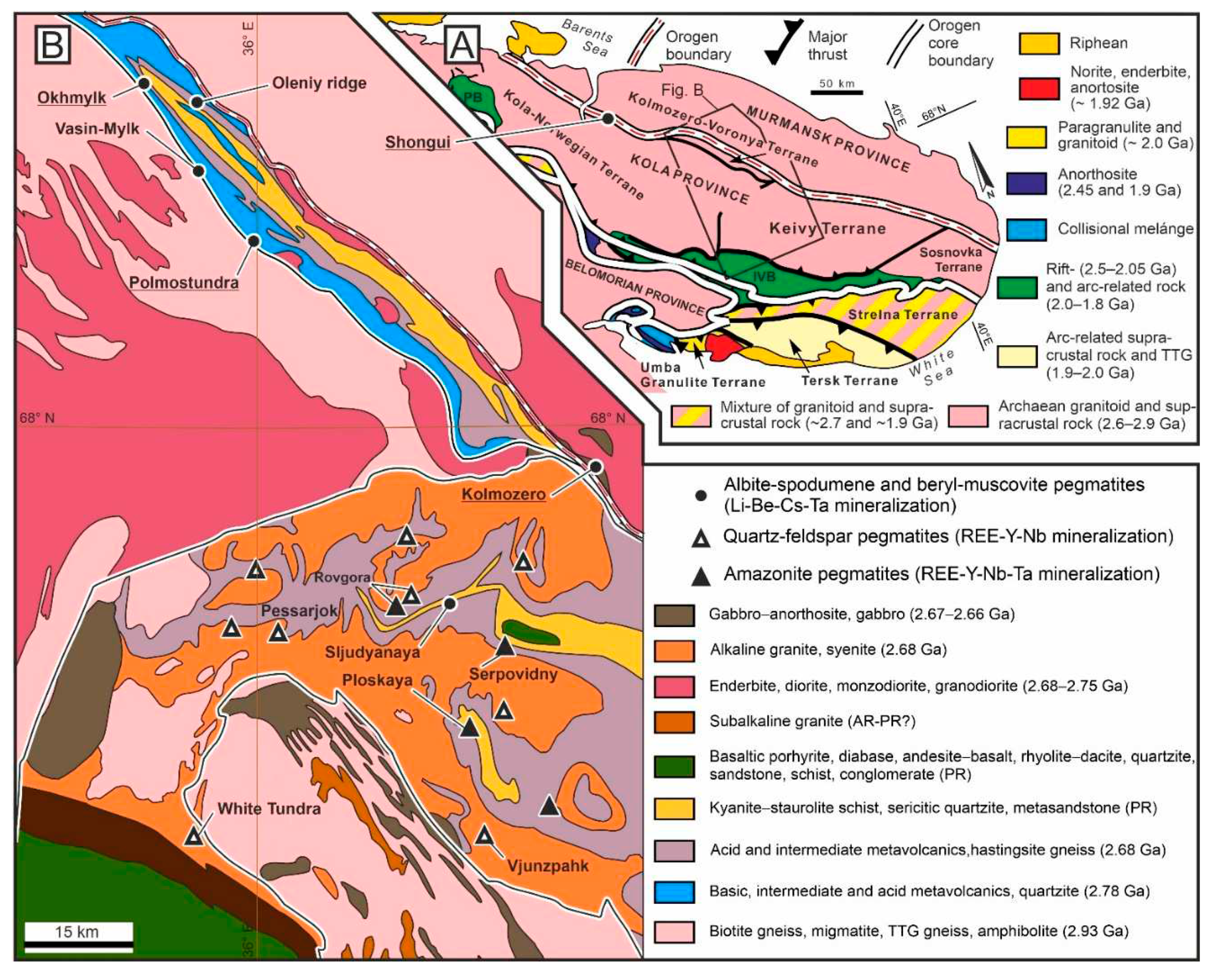

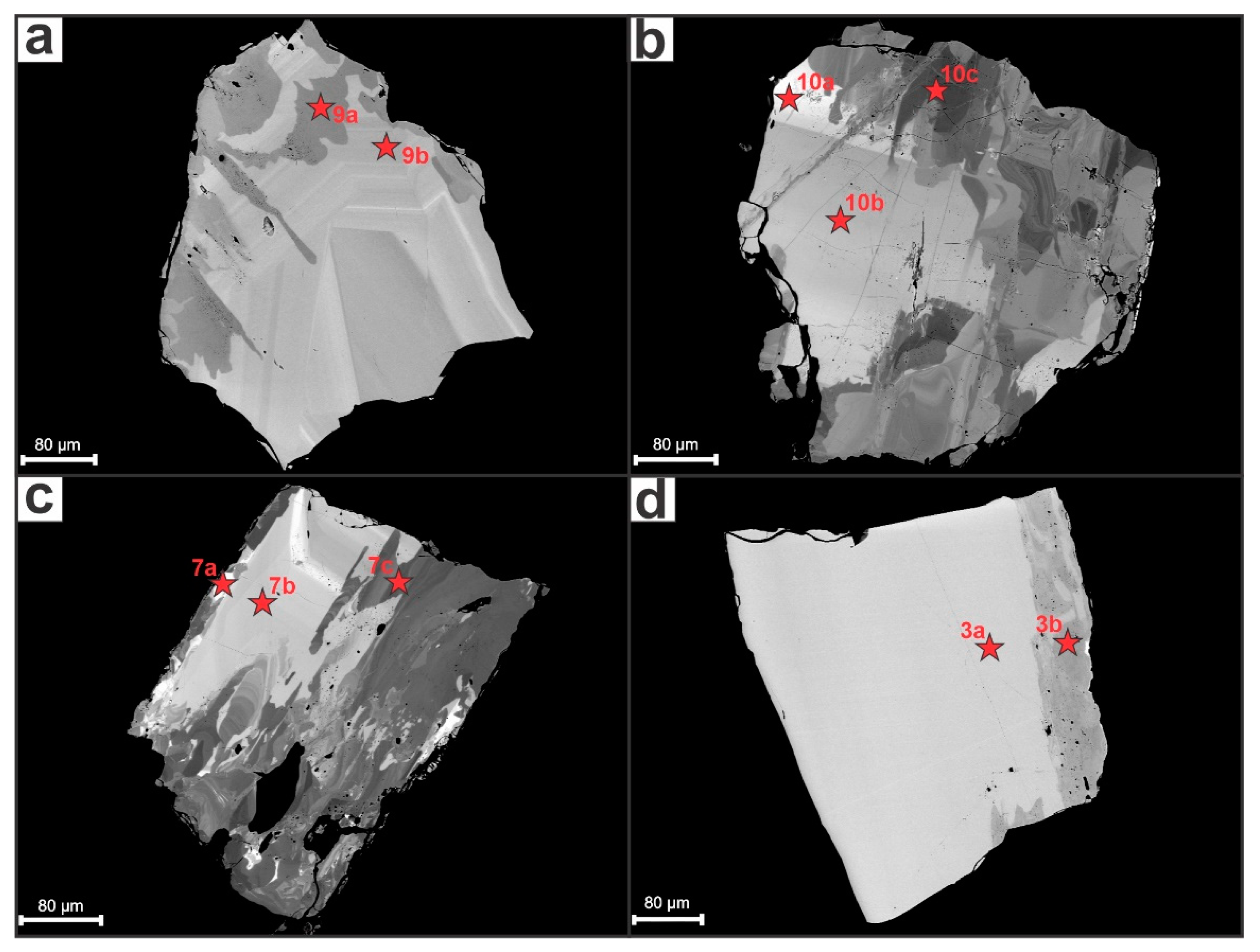
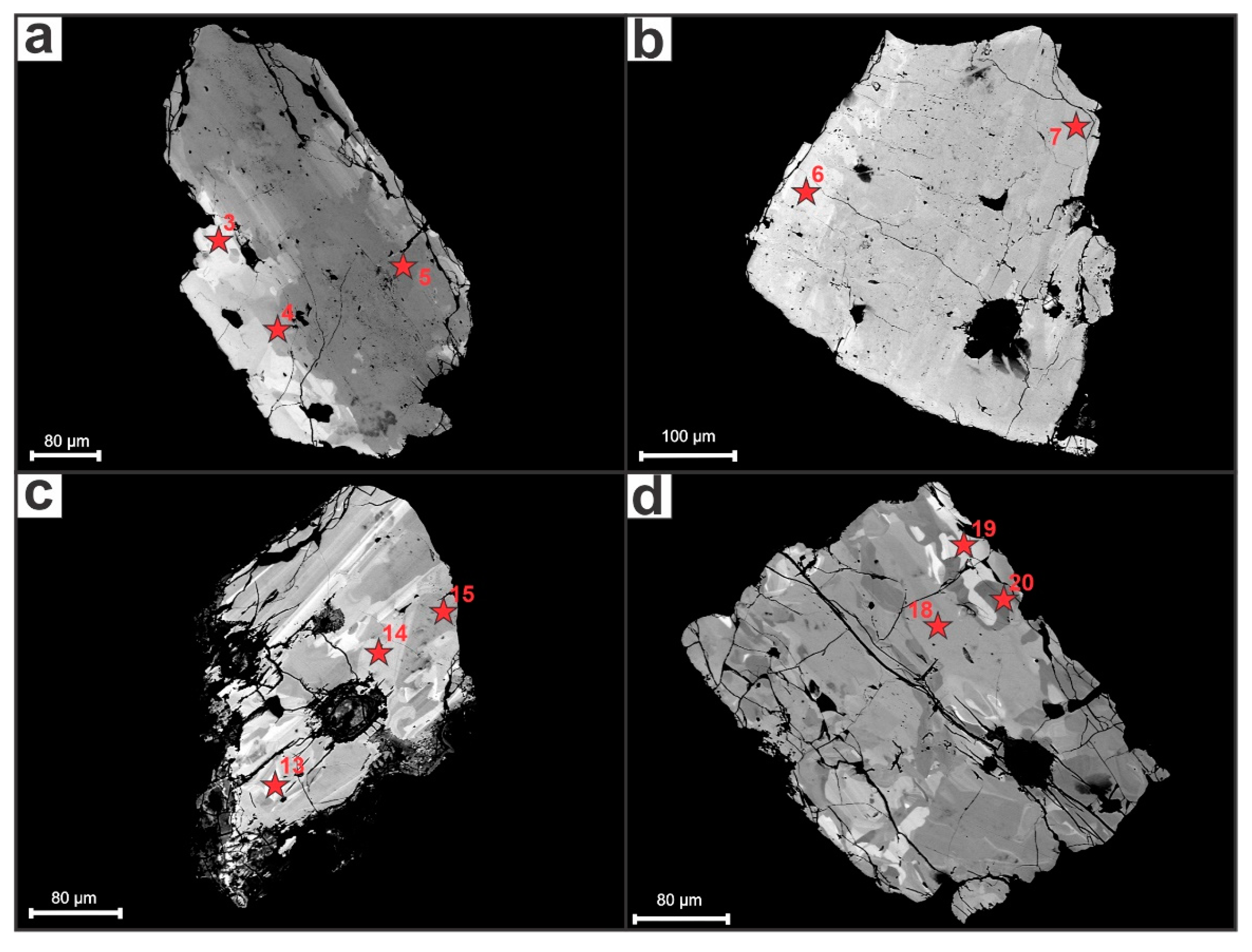
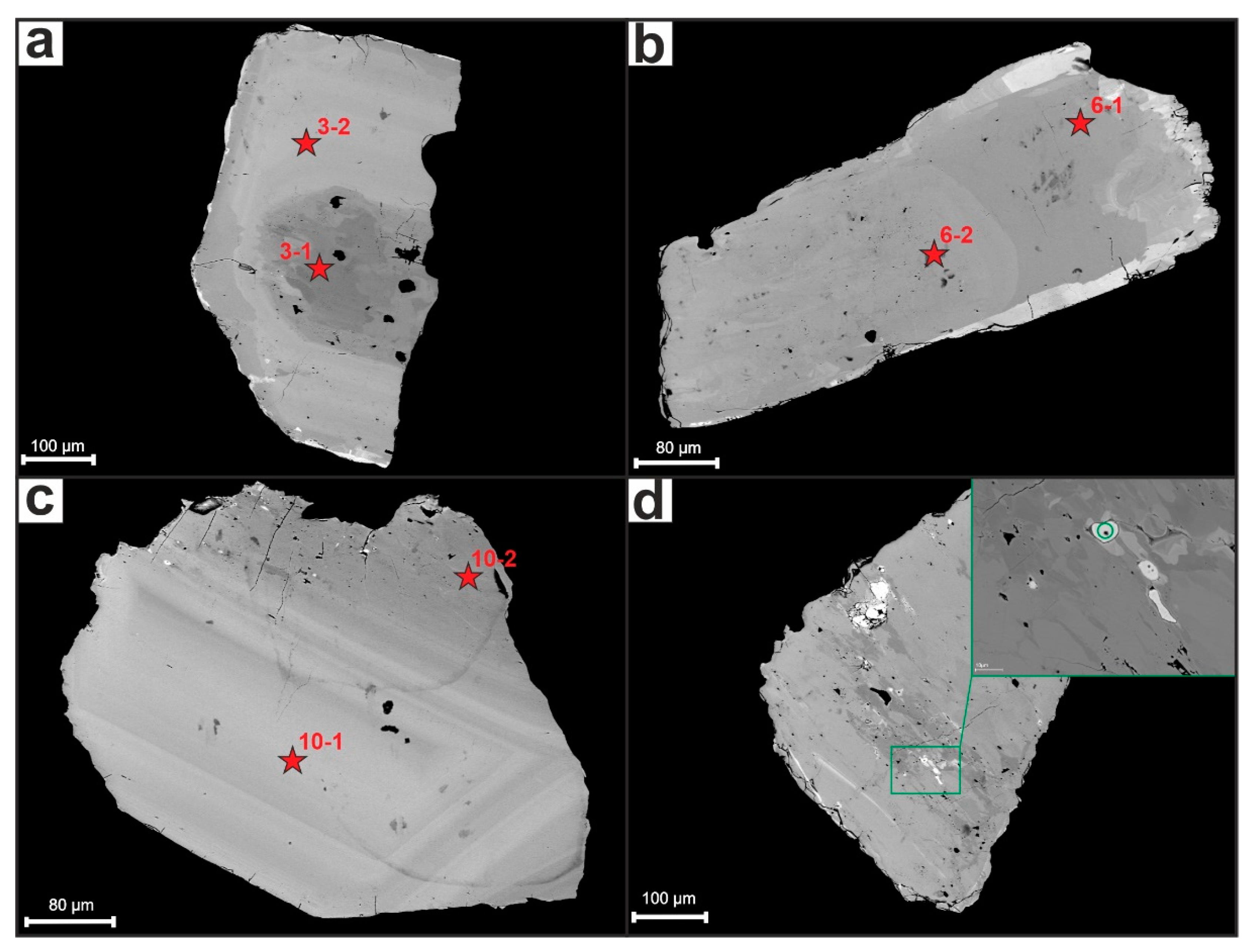
| Deposit/Occurrence | Kolmozero | Polmostundra | Okhmylk | Shongui |
| Sample N | KL-GX-11 | POL-GХ-3/5 | ОKH-2/2 | SH-7 |
| Major and minor minerals | quartz, 50-60 %; feldspar (microcline + albite), 20-25 %; spodumene, 20% |
quartz, 50-60 %; feldspar (microcline + albite), 25-30%; lepidolite, 10%; spodumene, 3% |
quartz, 50-60 %; feldspar (microcline + albite), 40-45 %; tourmaline (mainly schorl), 3%; spodumene, 1% |
quartz, 60-65%; feldspar (mainly albite), 35-40% |
| Accessory minerals | garnet, apatite, magnetite, ilmenite | apatite, tourmaline, garnet, magnetite, rutile, ilmenite | apatite, magnetite, garnet | beryl, tourmaline, apatite, garnet, magnetite, |
| Nb-Ta-Sn oxides | CGM | CGM, pyrochlore/microlite | CGM, pyrochlore, cassiterite | CGM, pyrochlore |
| Wet chemistry (wt.%) | ||||
| SiO2 | 75.52 | 75.08 | 76.10 | 85.33 |
| TiO2 | <0.01 | <0.01 | 0.03 | 0.02 |
| Al2O3 | 14.81 | 12.75 | 12.10 | 7.33 |
| Fe2O3 | 0 | 0.11 | 0.00 | 0.09 |
| FeO | 2.69 | 1.89 | 1.57 | 1.67 |
| MnO | 0.11 | 0.065 | 0.04 | 0.18 |
| MgO | 0.17 | 0.08 | 0.12 | 0.24 |
| CaO | 0.1 | 0.11 | 0.23 | 0.20 |
| Na2O | 2.48 | 3.59 | 6.11 | 4.15 |
| K2O | 1.25 | 3.5 | 2.40 | 0.17 |
| Li2O | 2.27 | 0.55 | 0.138 | 0.005 |
| CO2 | 0.25 | 0.02 | <0.1 | <0.1 |
| F | 0.014 | 0.32 | 0.017 | 0.007 |
| Cl | 0.005 | 0.005 | 0.007 | 0.011 |
| P2O5 | 0.08 | 0.34 | 0.13 | 0.10 |
| ICP-MS (ppm) | ||||
| Li | 11000 | 2200 | 800 | 29 |
| Be | 100 | 13 | 7 | 27 |
| Rb | 500 | 4300 | 600 | 11 |
| Nb | 49 | 50 | 80 | 23 |
| Sn | 30 | 31 | 4 | 1,8 |
| Cs | 30 | 2200 | 70 | 17 |
| Ta | 17 | 160 | 18 | 8.5 |
| W | 1.2 | 24 | 1.4 | 0.3 |
| Kolmozero | |||||||||||||||||||||||||||||||
| Sample # | 6 | 7 | 8 | 9 | 10 | 11 | 12 | 13 | 14 | 19 | 20 | ||||||||||||||||||||
| MgO | 0.07 | 0.06 | 0.05 | 0,00 | 0,06 | 0.00 | 0.00 | 0.00 | 0.07 | 0.00 | 0.00 | ||||||||||||||||||||
| Al2O3 | 0.00 | 0.00 | 0.00 | 0.00 | 0.00 | 0.07 | 0.00 | 0.00 | 0.00 | 0.00 | 0.00 | ||||||||||||||||||||
| SiO2 | 0.79 | 0.61 | 0.36 | 0.52 | 1.40 | 0.92 | 0.25 | 0.47 | 0.39 | 0.17 | 0.22 | ||||||||||||||||||||
| CaO | 0.06 | 0.05 | 0.05 | 0.05 | 0.14 | 0.05 | 0.19 | 0.09 | 0.04 | 0.00 | 0.00 | ||||||||||||||||||||
| TiO2 | 0.75 | 0.60 | 0.46 | 0.48 | 0.90 | 0.78 | 0.49 | 0.46 | 0.47 | 0.29 | 0.44 | ||||||||||||||||||||
| V2O5 | 0.00 | 0.00 | 0.00 | 0.00 | 0.00 | 0.00 | 0.00 | 0.00 | 0.00 | 0.07 | 0.08 | ||||||||||||||||||||
| MnO | 7.44 | 7.79 | 8.66 | 8.45 | 2.78 | 8.18 | 8.54 | 11.20 | 7.98 | 11.11 | 11.08 | ||||||||||||||||||||
| FeO | 8.94 | 9.45 | 10.37 | 9.57 | 12.30 | 7.87 | 10.28 | 9.46 | 10.00 | 8.43 | 8.54 | ||||||||||||||||||||
| ZnO | 0.17 | 0.12 | 0.07 | 0.13 | 0.13 | 0.20 | 0.00 | 0.11 | 0.13 | 0.00 | 0.00 | ||||||||||||||||||||
| ZrO2 | 0.00 | 0.00 | 0.00 | 0.00 | 0.00 | 0.00 | 0.00 | 0.00 | 0.00 | 0.00 | 0.00 | ||||||||||||||||||||
| Nb2O5 | 16.68 | 26.22 | 42.85 | 34.02 | 11.85 | 13.89 | 56.78 | 40.56 | 41.87 | 54.20 | 52.83 | ||||||||||||||||||||
| SnO2 | 0.00 | 0.00 | 0.00 | 0.00 | 0.50 | 0.33 | 0.00 | 0.00 | 0.00 | 0.00 | 0.00 | ||||||||||||||||||||
| Ta2O5 | 64.08 | 53.97 | 35.40 | 46.12 | 69.99 | 67.62 | 21.92 | 37.37 | 38.28 | 24.03 | 24.57 | ||||||||||||||||||||
| WO3 | 0.40 | 0.25 | 0.24 | 0.24 | 0.44 | 0.36 | 0.00 | 0.27 | 0.43 | 0.00 | 0.61 | ||||||||||||||||||||
| UO2 | 0.00 | 0.00 | 0.00 | 0.00 | 0.00 | 0.00 | 0.00 | 0.00 | 0.00 | 0.00 | 0.00 | ||||||||||||||||||||
| Sc2O3 | |||||||||||||||||||||||||||||||
| Total | 99.38 | 99.12 | 98.50 | 99.58 | 100.49 | 100.26 | 98.45 | 99.99 | 99.66 | 98.30 | 98.35 | ||||||||||||||||||||
| Zoning | p | p | p | p | r | h (porous) | o | o | o | h | h | ||||||||||||||||||||
| Formulae on basis of 6 oxygens | |||||||||||||||||||||||||||||||
| Si | 0.059 | 0.044 | 0.024 | 0.036 | 0.106 | 0.070 | 0.015 | 0.031 | 0.026 | 0.011 | 0.014 | ||||||||||||||||||||
| Al | 0.000 | 0.000 | 0.000 | 0.000 | 0.000 | 0.006 | 0.000 | 0.000 | 0.000 | 0.000 | 0.000 | ||||||||||||||||||||
| Ti | 0.043 | 0.032 | 0.023 | 0.025 | 0.051 | 0.044 | 0.023 | 0.023 | 0.023 | 0.014 | 0.021 | ||||||||||||||||||||
| Fe2+ | 0.564 | 0.569 | 0.576 | 0.552 | 0.783 | 0.499 | 0.536 | 0.524 | 0.554 | 0.445 | 0.453 | ||||||||||||||||||||
| Mn | 0.476 | 0.475 | 0.488 | 0.493 | 0.179 | 0.526 | 0.451 | 0.628 | 0.448 | 0.595 | 0.595 | ||||||||||||||||||||
| Mg | 0.008 | 0.006 | 0.005 | 0.000 | 0.007 | 0.000 | 0.000 | 0.000 | 0.007 | 0.000 | 0.000 | ||||||||||||||||||||
| Zn | 0.010 | 0.006 | 0.004 | 0.007 | 0.007 | 0.011 | 0.000 | 0.005 | 0.006 | 0.000 | 0.000 | ||||||||||||||||||||
| Ca | 0.005 | 0.004 | 0.003 | 0.003 | 0.011 | 0.004 | 0.012 | 0.007 | 0.003 | 0.000 | 0.000 | ||||||||||||||||||||
| Nb | 0.569 | 0.853 | 1.288 | 1.060 | 0.408 | 0.477 | 1.599 | 1.214 | 1.254 | 1.548 | 1.514 | ||||||||||||||||||||
| Ta | 1.315 | 1.056 | 0.640 | 0.864 | 1.449 | 1.396 | 0.371 | 0.673 | 0.690 | 0.413 | 0.424 | ||||||||||||||||||||
| U | 0.000 | 0.000 | 0.000 | 0.000 | 0.000 | 0.000 | 0.000 | 0.000 | 0.000 | 0.000 | 0.000 | ||||||||||||||||||||
| Sn | 0.000 | 0.000 | 0.000 | 0.000 | 0.015 | 0.010 | 0.000 | 0.000 | 0.000 | 0.000 | 0.000 | ||||||||||||||||||||
| W | 0.008 | 0.005 | 0.004 | 0.004 | 0.009 | 0.007 | 0.000 | 0.005 | 0.007 | 0.000 | 0.010 | ||||||||||||||||||||
| V | 0.000 | 0.000 | 0.000 | 0.000 | 0.000 | 0.000 | 0.000 | 0.000 | 0.000 | 0.002 | 0.002 | ||||||||||||||||||||
| Sc | |||||||||||||||||||||||||||||||
| A | 1.062 | 1.060 | 1.075 | 1.055 | 1.002 | 1.051 | 0.999 | 1.163 | 1.018 | 1.040 | 1.048 | ||||||||||||||||||||
| B | 1.986 | 1.986 | 1.974 | 1.985 | 2.014 | 1.986 | 2.008 | 1.940 | 1.994 | 1.987 | 1.974 | ||||||||||||||||||||
| Ta/(Ta+Nb) | 0.698 | 0.553 | 0.332 | 0.449 | 0.780 | 0.745 | 0.188 | 0.357 | 0.355 | 0.211 | 0.219 | ||||||||||||||||||||
| Mn/(Mn+Fe) | 0.457 | 0.455 | 0.458 | 0.472 | 0.186 | 0.513 | 0.457 | 0.545 | 0.447 | 0.572 | 0.568 | ||||||||||||||||||||
| Sample # | Polmostundra | ||||||||||||||||||||||||||||||
| 3a | 3b | 7a | 7b | 7c | 9a | 9b | 10a | 10b | 10c | ||||||||||||||||||||||
| MgO | 0.11 | 0.00 | 0.08 | 0.00 | 0.10 | 0.15 | 0.11 | 0.09 | 0.13 | 0.00 | |||||||||||||||||||||
| Al2O3 | 0.00 | 0.00 | 0.00 | 0.00 | 0.00 | 0.00 | 0.00 | 0.00 | 0.00 | 0.00 | |||||||||||||||||||||
| SiO2 | 0.18 | 0.10 | 0.69 | 0.51 | 0.17 | 0.10 | 0.17 | 0.65 | 0.39 | 0.08 | |||||||||||||||||||||
| CaO | 0.00 | 0.00 | 0.00 | 0.00 | 0.00 | 0.00 | 0.00 | 0.00 | 0.00 | 0.00 | |||||||||||||||||||||
| TiO2 | 0.41 | 1.01 | 0.77 | 0.41 | 0.76 | 0.78 | 0.57 | 1.07 | 0.63 | 0.88 | |||||||||||||||||||||
| V2O5 | 0.00 | 0.00 | 0.00 | 0.00 | 0.00 | 0.00 | 0.00 | 0.06 | 0.00 | 0.00 | |||||||||||||||||||||
| MnO | 4.49 | 6.87 | 4.80 | 5.39 | 3.61 | 4.54 | 5.95 | 6.18 | 4.23 | 4.55 | |||||||||||||||||||||
| FeO | 15.70 | 13.89 | 12.33 | 12.02 | 16.53 | 16.06 | 14.43 | 13.08 | 14.34 | 15.80 | |||||||||||||||||||||
| ZnO | 0.00 | 0.00 | 0.16 | 0.11 | 0.11 | 0.00 | 0.00 | 0.13 | 0.10 | 0.00 | |||||||||||||||||||||
| ZrO2 | 0.00 | 0.00 | 0.00 | 0.00 | 0.00 | 0.00 | 0.00 | 0.00 | 0.00 | 0.00 | |||||||||||||||||||||
| Nb2O5 | 61.84 | 67.68 | 38.57 | 42.83 | 60.60 | 68.52 | 62.35 | 36.04 | 47.08 | 68.73 | |||||||||||||||||||||
| SnO2 | 0.00 | 0.00 | 0.45 | 0.31 | 0.00 | 0.00 | 0.00 | 0.84 | 0.35 | 0.00 | |||||||||||||||||||||
| Ta2O5 | 14.90 | 8.90 | 39.75 | 36.11 | 16.76 | 8.22 | 14.55 | 39.17 | 30.12 | 8.13 | |||||||||||||||||||||
| WO3 | 0.30 | 0.45 | 0.41 | 0.53 | 0.38 | 0.41 | 0.53 | 0.54 | 0.54 | 0.34 | |||||||||||||||||||||
| UO2 | 0.00 | 0.00 | 0.00 | 0.00 | 0.00 | 0.00 | 0.00 | 0.00 | 0.00 | 0.00 | |||||||||||||||||||||
| Sc2O3 | |||||||||||||||||||||||||||||||
| Total | 97.92 | 98.89 | 98.01 | 98.23 | 99.03 | 98.77 | 98.66 | 97.86 | 97.90 | 98.52 | |||||||||||||||||||||
| Zoning | h | h (reverse) | p | p | p | m | o | r | h | m | |||||||||||||||||||||
| Formulae on basis of 6 oxygens | |||||||||||||||||||||||||||||||
| Si | 0.011 | 0.006 | 0.047 | 0.034 | 0.011 | 0.006 | 0.010 | 0.044 | 0.025 | 0.005 | |||||||||||||||||||||
| Al | 0.000 | 0.000 | 0.000 | 0.000 | 0.000 | 0.000 | 0.000 | 0.000 | 0.000 | 0.000 | |||||||||||||||||||||
| Ti | 0.019 | 0.044 | 0.039 | 0.021 | 0.035 | 0.034 | 0.026 | 0.055 | 0.031 | 0.039 | |||||||||||||||||||||
| Fe2+ | 0.801 | 0.683 | 0.700 | 0.670 | 0.840 | 0.788 | 0.730 | 0.747 | 0.783 | 0.777 | |||||||||||||||||||||
| Mn | 0.232 | 0.342 | 0.276 | 0.305 | 0.186 | 0.226 | 0.305 | 0.357 | 0.234 | 0.227 | |||||||||||||||||||||
| Mg | 0.010 | 0.000 | 0.008 | 0.000 | 0.009 | 0.013 | 0.010 | 0.009 | 0.012 | 0.000 | |||||||||||||||||||||
| Zn | 0.000 | 0.000 | 0.008 | 0.005 | 0.005 | 0.000 | 0.000 | 0.007 | 0.005 | 0.000 | |||||||||||||||||||||
| Ca | 0.000 | 0.000 | 0.000 | 0.000 | 0.000 | 0.000 | 0.000 | 0.000 | 0.000 | 0.000 | |||||||||||||||||||||
| Nb | 1.706 | 1.799 | 1.183 | 1.291 | 1.664 | 1.818 | 1.704 | 1.113 | 1.389 | 1.827 | |||||||||||||||||||||
| Ta | 0.247 | 0.142 | 0.733 | 0.655 | 0.277 | 0.131 | 0.239 | 0.727 | 0.535 | 0.130 | |||||||||||||||||||||
| U | 0.000 | 0.000 | 0.000 | 0.000 | 0.000 | 0.000 | 0.000 | 0.000 | 0.000 | 0.000 | |||||||||||||||||||||
| Sn | 0.000 | 0.000 | 0.012 | 0.008 | 0.000 | 0.000 | 0.000 | 0.023 | 0.009 | 0.000 | |||||||||||||||||||||
| W | 0.005 | 0.007 | 0.007 | 0.009 | 0.006 | 0.006 | 0.008 | 0.010 | 0.009 | 0.005 | |||||||||||||||||||||
| V | 0.000 | 0.000 | 0.000 | 0.000 | 0.000 | 0.000 | 0.000 | 0.001 | 0.000 | 0.000 | |||||||||||||||||||||
| Sc | 0.000 | 0.000 | 0.000 | 0.000 | 0.000 | 0.000 | 0.000 | 0.000 | 0.000 | 0.000 | |||||||||||||||||||||
| A | 1.043 | 1.025 | 0.992 | 0.980 | 1.040 | 1.027 | 1.044 | 1.120 | 1.034 | 1.004 | |||||||||||||||||||||
| B | 1.983 | 1.992 | 2.014 | 2.009 | 1.986 | 1.990 | 1.980 | 1.963 | 1.989 | 2.001 | |||||||||||||||||||||
| Ta/(Ta+Nb) | 0.127 | 0.073 | 0.383 | 0.337 | 0.143 | 0.067 | 0.123 | 0.395 | 0.278 | 0.066 | |||||||||||||||||||||
| Mn/(Mn+Fe) | 0.225 | 0.334 | 0.283 | 0.312 | 0.181 | 0.223 | 0.294 | 0.324 | 0.230 | 0.226 | |||||||||||||||||||||
| Okhmylk | |||||||||||||||||||||||||||||||
| Sample # | 3 | 4 | 5 | 6 | 7 | 13 | 14 | 15 | 18 | 19 | |||||||||||||||||||||
| MgO | 0.00 | 0.00 | 0.00 | 0.00 | 0.00 | 0.00 | 0.00 | 0.00 | 0.00 | 0.00 | |||||||||||||||||||||
| Al2O3 | 0.04 | 0.00 | 0.00 | 0.00 | 0.07 | 0.00 | 0.00 | 0.00 | 0.00 | 0.00 | |||||||||||||||||||||
| SiO2 | 0.26 | 0.16 | 0.10 | 0.13 | 0.14 | 0.23 | 0.00 | 0.17 | 0.17 | 0.33 | |||||||||||||||||||||
| CaO | 0.00 | 0.06 | 0.00 | 0.00 | 0.00 | 0.00 | 0.00 | 0.00 | 0.00 | 0.00 | |||||||||||||||||||||
| TiO2 | 0.09 | 0.35 | 0.56 | 0.52 | 0.58 | 0.10 | 0.22 | 0.09 | 0.12 | 0.15 | |||||||||||||||||||||
| V2O5 | 0.00 | 0.00 | 0.00 | 0.00 | 0.00 | 0.00 | 0.00 | 0.00 | 0.00 | 0.00 | |||||||||||||||||||||
| MnO | 15.47 | 16.14 | 12.98 | 7.85 | 10.77 | 16.06 | 17.65 | 17.52 | 15.59 | 14.56 | |||||||||||||||||||||
| FeO | 3.92 | 3.47 | 8.00 | 12.83 | 8.30 | 3.17 | 1.85 | 1.53 | 3.96 | 4.26 | |||||||||||||||||||||
| ZnO | 0.00 | 0.02 | 0.00 | 0.00 | 0.00 | 0.00 | 0.00 | 0.00 | 0.00 | 0.00 | |||||||||||||||||||||
| ZrO2 | 0.00 | 0.00 | 0.00 | 0.00 | 0.00 | 0.00 | 0.00 | 0.00 | 0.00 | 0.00 | |||||||||||||||||||||
| Nb2O5 | 54.44 | 62.17 | 66.94 | 61.59 | 67.03 | 53.70 | 56.61 | 64.37 | 54.26 | 51.93 | |||||||||||||||||||||
| SnO2 | 0.00 | 0.00 | 0.00 | 0.00 | 0.00 | 0.00 | 0.00 | 0.00 | 0.00 | 0.00 | |||||||||||||||||||||
| Ta2O5 | 23.31 | 16.13 | 10.77 | 14.41 | 12.53 | 25.05 | 20.87 | 16.77 | 22.70 | 26.91 | |||||||||||||||||||||
| WO3 | 0.47 | 0.84 | 0.73 | 1.15 | 0.86 | 0.36 | 0.50 | 0.38 | 0.42 | 0.43 | |||||||||||||||||||||
| UO2 | 0.15 | 0.00 | 0.00 | 0.00 | 0.00 | ||||||||||||||||||||||||||
| Sc2O3 | 0.00 | 0.15 | 0.16 | 0.18 | 0.23 | 0.11 | 0.14 | 0.08 | 0.10 | 0.14 | |||||||||||||||||||||
| Total | 98.14 | 99.49 | 100.24 | 98.66 | 100.51 | 98.77 | 97.84 | 100.92 | 97.32 | 98.71 | |||||||||||||||||||||
| Zoning | p(rim) | p(interm) | p(core) | r | ce | p | p | p | p(core) | p(rim) | |||||||||||||||||||||
| Formulae on basis of 6 oxygens | |||||||||||||||||||||||||||||||
| Si | 0.016 | 0.010 | 0.006 | 0.008 | 0.008 | 0.014 | 0.000 | 0.010 | 0.011 | 0.021 | |||||||||||||||||||||
| Al | 0.003 | 0.000 | 0.000 | 0.000 | 0.005 | 0.000 | 0.000 | 0.000 | 0.000 | 0.000 | |||||||||||||||||||||
| Ti | 0.004 | 0.016 | 0.025 | 0.024 | 0.026 | 0.005 | 0.010 | 0.004 | 0.005 | 0.007 | |||||||||||||||||||||
| Fe2+ | 0.205 | 0.175 | 0.389 | 0.644 | 0.411 | 0.167 | 0.097 | 0.077 | 0.209 | 0.226 | |||||||||||||||||||||
| Mn | 0.821 | 0.824 | 0.639 | 0.399 | 0.540 | 0.855 | 0.933 | 0.888 | 0.833 | 0.783 | |||||||||||||||||||||
| Mg | 0.000 | 0.000 | 0.000 | 0.000 | 0.000 | 0.000 | 0.000 | 0.000 | 0.000 | 0.000 | |||||||||||||||||||||
| Zn | 0.000 | 0.000 | 0.000 | 0.000 | 0.000 | 0.000 | 0.000 | 0.000 | 0.000 | 0.000 | |||||||||||||||||||||
| Ca | 0.000 | 0.004 | 0.000 | 0.000 | 0.000 | 0.000 | 0.000 | 0.000 | 0.000 | 0.000 | |||||||||||||||||||||
| Nb | 1.543 | 1.694 | 1.760 | 1.672 | 1.795 | 1.526 | 1.597 | 1.742 | 1.547 | 1.491 | |||||||||||||||||||||
| Ta | 0.397 | 0.264 | 0.170 | 0.235 | 0.202 | 0.428 | 0.354 | 0.273 | 0.389 | 0.465 | |||||||||||||||||||||
| U | 0.002 | 0.000 | 0.000 | 0.000 | 0.000 | 0.000 | 0.000 | 0.000 | 0.000 | 0.000 | |||||||||||||||||||||
| Sn | 0.000 | 0.000 | 0.000 | 0.000 | 0.000 | 0.000 | 0.000 | 0.000 | 0.000 | 0.000 | |||||||||||||||||||||
| W | 0.008 | 0.013 | 0.011 | 0.018 | 0.013 | 0.006 | 0.008 | 0.006 | 0.007 | 0.007 | |||||||||||||||||||||
| V | 0.000 | 0.000 | 0.000 | 0.000 | 0.000 | 0.000 | 0.000 | 0.000 | 0.000 | 0.000 | |||||||||||||||||||||
| Sc | 0.000 | 0.004 | 0.004 | 0.005 | 0.006 | 0.003 | 0.004 | 0.002 | 0.003 | 0.004 | |||||||||||||||||||||
| A | 1.027 | 1.003 | 1.028 | 1.043 | 0.952 | 1.022 | 1.030 | 0.965 | 1.041 | 1.009 | |||||||||||||||||||||
| B | 1.961 | 1.984 | 1.961 | 1.939 | 2.031 | 1.973 | 1.962 | 2.029 | 1.952 | 1.984 | |||||||||||||||||||||
| Ta/(Ta+Nb) | 0.205 | 0.135 | 0.088 | 0.123 | 0.101 | 0.219 | 0.182 | 0.135 | 0.201 | 0.238 | |||||||||||||||||||||
| Mn/(Mn+Fe) | 0.800 | 0.825 | 0.622 | 0.383 | 0.568 | 0.837 | 0.906 | 0.921 | 0.800 | 0.776 | |||||||||||||||||||||
| Shongui | |||||||||||||||||||||||||||||||
| Sample # | 3-1 | 3-2 | 6-1 | 6-2 | 7-1 | 7-2 | 10-1 | 10-2 | |||||||||||||||||||||||
| MgO | 0.07 | 0.00 | 0.00 | 0.00 | 0.00 | 0.00 | 0.10 | 0.00 | |||||||||||||||||||||||
| Al2O3 | 0.00 | 0.00 | 0.00 | 0.00 | 1.72 | 0.00 | 0.00 | 0.00 | |||||||||||||||||||||||
| SiO2 | 0.00 | 0.00 | 0.10 | 0.09 | 0.30 | 0.13 | 0.22 | 0.12 | |||||||||||||||||||||||
| CaO | 0.00 | 0.00 | 0.00 | 0.00 | 0.00 | 0.00 | 0.00 | 0.00 | |||||||||||||||||||||||
| TiO2 | 2.12 | 1.05 | 0.50 | 0.60 | 0.61 | 0.60 | 1.50 | 1.69 | |||||||||||||||||||||||
| V2O5 | 0.00 | 0.00 | 0.00 | 0.00 | 0.00 | 0.00 | 0.00 | 0.00 | |||||||||||||||||||||||
| MnO | 6.13 | 6.67 | 8.06 | 7.91 | 10.20 | 7.29 | 6.39 | 8.82 | |||||||||||||||||||||||
| FeO | 13.83 | 12.98 | 12.34 | 12.84 | 9.29 | 12.87 | 13.27 | 11.21 | |||||||||||||||||||||||
| ZnO | 0.04 | 0.00 | 0.00 | 0.00 | 0.00 | 0.00 | 0.00 | 0.00 | |||||||||||||||||||||||
| ZrO2 | 0.00 | 0.00 | 0.00 | 0.00 | 0.00 | 0.00 | 0.00 | 0.00 | |||||||||||||||||||||||
| Nb2O5 | 67.42 | 62.36 | 62.45 | 60.75 | 51.71 | 60.63 | 54.88 | 58.08 | |||||||||||||||||||||||
| SnO2 | 0.20 | 0.00 | 0.00 | 0.00 | 0.00 | 0.00 | 0.00 | 0.00 | |||||||||||||||||||||||
| Ta2O5 | 8.04 | 15.53 | 15.04 | 16.21 | 24.96 | 16.84 | 22.49 | 17.64 | |||||||||||||||||||||||
| WO3 | 0.30 | 0.00 | 0.00 | 0.00 | 0.00 | 0.00 | 0.00 | 0.00 | |||||||||||||||||||||||
| UO2 | 0.00 | 0.00 | 0.00 | 0.00 | 0.00 | 0.00 | 0.00 | 0.00 | |||||||||||||||||||||||
| Sc2O3 | 0.40 | 0.20 | 0.00 | 0.00 | 0.00 | 0.00 | 0.25 | 0.36 | |||||||||||||||||||||||
| Total | 98.55 | 98.79 | 98.48 | 98.39 | 98.80 | 98.35 | 99.08 | 97.93 | |||||||||||||||||||||||
| Zoning | c | r | h | h | r | h | o | o | |||||||||||||||||||||||
| Formulae on basis of 6 oxygens | |||||||||||||||||||||||||||||||
| Si | 0.000 | 0.000 | 0.006 | 0.005 | 0.018 | 0.008 | 0.013 | 0.007 | |||||||||||||||||||||||
| Al | 0.000 | 0.000 | 0.000 | 0.000 | 0.123 | 0.000 | 0.000 | 0.000 | |||||||||||||||||||||||
| Ti | 0.093 | 0.048 | 0.023 | 0.027 | 0.028 | 0.027 | 0.069 | 0.077 | |||||||||||||||||||||||
| Fe2+ | 0.676 | 0.655 | 0.620 | 0.646 | 0.472 | 0.652 | 0.680 | 0.571 | |||||||||||||||||||||||
| Mn | 0.303 | 0.341 | 0.410 | 0.403 | 0.525 | 0.374 | 0.332 | 0.455 | |||||||||||||||||||||||
| Mg | 0.006 | 0.000 | 0.000 | 0.000 | 0.000 | 0.000 | 0.009 | 0.000 | |||||||||||||||||||||||
| Zn | 0.002 | 0.000 | 0.000 | 0.000 | 0.000 | 0.000 | 0.000 | 0.000 | |||||||||||||||||||||||
| Ca | 0.000 | 0.000 | 0.000 | 0.000 | 0.000 | 0.000 | 0.000 | 0.000 | |||||||||||||||||||||||
| Nb | 1.782 | 1.701 | 1.696 | 1.653 | 1.421 | 1.661 | 1.522 | 1.598 | |||||||||||||||||||||||
| Ta | 0.128 | 0.255 | 0.246 | 0.265 | 0.413 | 0.278 | 0.375 | 0.292 | |||||||||||||||||||||||
| U | 0.000 | 0.000 | 0.000 | 0.000 | 0.000 | 0.000 | 0.000 | 0.000 | |||||||||||||||||||||||
| Sn | 0.005 | 0.000 | 0.000 | 0.000 | 0.000 | 0.000 | 0.000 | 0.000 | |||||||||||||||||||||||
| W | 0.005 | 0.000 | 0.000 | 0.000 | 0.000 | 0.000 | 0.000 | 0.000 | |||||||||||||||||||||||
| V | 0.000 | 0.000 | 0.000 | 0.000 | 0.000 | 0.000 | 0.000 | 0.000 | |||||||||||||||||||||||
| Sc | 0.010 | 0.005 | 0.000 | 0.000 | 0.000 | 0.000 | 0.007 | 0.010 | |||||||||||||||||||||||
| A | 0.988 | 0.996 | 1.030 | 1.049 | 0.997 | 1.026 | 1.021 | 1.025 | |||||||||||||||||||||||
| B | 2.008 | 2.004 | 1.970 | 1.951 | 1.879 | 1.974 | 1.979 | 1.975 | |||||||||||||||||||||||
| Ta/(Ta+Nb) | 0.067 | 0.130 | 0.127 | 0.138 | 0.225 | 0.143 | 0.198 | 0.154 | |||||||||||||||||||||||
| Mn/(Mn+Fe) | 0.310 | 0.342 | 0.398 | 0.384 | 0.526 | 0.364 | 0.328 | 0.443 | |||||||||||||||||||||||
| Polmostundra | ||||||||||||||||||||
| Sample # | Pcl 1 | Pcl 2 | Pcl 3 | Pcl 4 | Pcl 5 | Pcl 6 | Pcl 7 | Pcl 8 | 3-4 | 3-5 | ||||||||||
| Na2O | 4.77 | 5.18 | 5.26 | 5.43 | 4.71 | 5.22 | 4.57 | 5.20 | 3.04 | 2.57 | ||||||||||
| MgO | 0.00 | 0.00 | 0.00 | 0.00 | 0.06 | 0.00 | 0.00 | 0.00 | ||||||||||||
| Al2O3 | 0.00 | 0.00 | 0.04 | 0.03 | 0.00 | 0.00 | 0.00 | 0.00 | 0.00 | 0.00 | ||||||||||
| SiO2 | ||||||||||||||||||||
| K2O | 0.00 | 0.00 | 0.00 | 0.00 | 0.00 | 0.00 | 0.00 | 0.00 | 0.25 | |||||||||||
| CaO | 7.73 | 6.17 | 7.78 | 7.52 | 6.98 | 8.28 | 8.63 | 7.09 | 4.47 | 1.95 | ||||||||||
| TiO2 | 0.00 | 0.00 | 0.00 | 0.00 | 0.00 | 0.00 | 0.00 | 0.00 | ||||||||||||
| MnO | 0.00 | 0.00 | 0.11 | 0.00 | 0.22 | 0.00 | 0.14 | 0.17 | 0.18 | |||||||||||
| FeO | 0.00 | 0.00 | 0.00 | 0.00 | 0.00 | 0.00 | 0.00 | 0.00 | ||||||||||||
| As2O3 | ||||||||||||||||||||
| SrO | 2.78 | 1.76 | 1.09 | 1.36 | 0.88 | 1.15 | 1.29 | 2.01 | ||||||||||||
| Y2O3 | 3.04 | |||||||||||||||||||
| Nb2O5 | 1.97 | 2.18 | 1.26 | 2.52 | 2.27 | 2.00 | 2.63 | 2.36 | 2.11 | 2.22 | ||||||||||
| SnO2 | 0.00 | 0.28 | 0.30 | 0.81 | 1.13 | 0.34 | 0.66 | 0.55 | ||||||||||||
| Ta2O5 | 78.53 | 75.79 | 76.72 | 72.12 | 70.30 | 78.07 | 72.37 | 73.19 | 71.80 | 76.68 | ||||||||||
| WO3 | 0.70 | 1.20 | 0.68 | 1.03 | 0.96 | 0.96 | 1.11 | 1.02 | 8.80 | 6.51 | ||||||||||
| PbO | 0.00 | 1.07 | 1.54 | 1.60 | 2.81 | 0.58 | 1.45 | 2.04 | 2.83 | 3.95 | ||||||||||
| ThO2 | 0.60 | 0.00 | 0.00 | 0.00 | 0.00 | 0.00 | 0.31 | 0.00 | 0.01 | 0.00 | ||||||||||
| UO2 | 0.00 | 2.55 | 2.25 | 5.80 | 7.24 | 1.02 | 3.51 | 4.58 | 4.84 | 3.37 | ||||||||||
| F | 2.36 | 1.59 | 1.94 | 1.73 | 1.22 | 2.28 | 1.93 | 2.09 | 0.00 | |||||||||||
| Total | 99.44 | 97.76 | 98.95 | 99.93 | 98.76 | 99.90 | 98.59 | 100.29 | 100.94 | 97.68 | ||||||||||
| O=F | 0.99 | 0.67 | 0.82 | 0.73 | 0.51 | 0.96 | 0.81 | 0.88 | ||||||||||||
| H2Ocalc | 0.56 | 0.90 | 0.71 | 0.78 | 0.98 | 0.61 | 0.69 | 0.62 | 1.71 | 1.77 | ||||||||||
| Total | 99.00 | 97.99 | 98.85 | 99.99 | 99.23 | 99.54 | 98.47 | 100.03 | 102.65 | 99.45 | ||||||||||
| Formulae on basis of B=2 cations | ||||||||||||||||||||
| Na | 0.825 | 0.913 | 0.937 | 0.986 | 0.876 | 0.899 | 0.828 | 0.940 | 0.518 | 0.423 | ||||||||||
| K | 0.000 | 0.000 | 0.000 | 0.000 | 0.000 | 0.000 | 0.000 | 0.000 | 0.014 | |||||||||||
| Ca | 0.738 | 0.600 | 0.766 | 0.754 | 0.718 | 0.788 | 0.863 | 0.708 | 0.421 | 0.177 | ||||||||||
| Mn | 0.000 | 0.000 | 0.008 | 0.000 | 0.018 | 0.000 | 0.011 | 0.013 | 0.013 | |||||||||||
| Fe | ||||||||||||||||||||
| Sr | 0.144 | 0.093 | 0.058 | 0.074 | 0.049 | 0.059 | 0.070 | 0.108 | ||||||||||||
| As | ||||||||||||||||||||
| Y | 0.31 | |||||||||||||||||||
| Pb | 0.000 | 0.026 | 0.038 | 0.040 | 0.073 | 0.014 | 0.036 | 0.051 | 0.067 | 0.090 | ||||||||||
| Th | 0.012 | 0.000 | 0.000 | 0.000 | 0.000 | 0.000 | 0.007 | 0.000 | ||||||||||||
| U | 0.000 | 0.051 | 0.046 | 0.121 | 0.155 | 0.020 | 0.073 | 0.095 | 0.095 | 0.064 | ||||||||||
| ∑A | 1.719 | 1.683 | 1.854 | 1.975 | 1.896 | 1.781 | 1.888 | 1.916 | 1.101 | 0.781 | ||||||||||
| Mg | 0.000 | 0.000 | 0.000 | 0.000 | 0.008 | 0.000 | 0.000 | 0.000 | ||||||||||||
| Al | 0.000 | 0.000 | 0.004 | 0.003 | 0.000 | 0.000 | 0.000 | 0.000 | ||||||||||||
| Si | ||||||||||||||||||||
| Ti | 0.000 | 0.000 | 0.000 | 0.000 | 0.000 | 0.000 | 0.000 | 0.000 | ||||||||||||
| Nb | 0.079 | 0.089 | 0.052 | 0.107 | 0.098 | 0.080 | 0.111 | 0.099 | 0.084 | 0.085 | ||||||||||
| Sn | 0.000 | 0.010 | 0.011 | 0.030 | 0.043 | 0.012 | 0.025 | 0.021 | ||||||||||||
| Ta | 1.904 | 1.872 | 1.917 | 1.835 | 1.835 | 1.886 | 1.838 | 1.855 | 1.716 | 1.771 | ||||||||||
| W | 0.016 | 0.028 | 0.016 | 0.025 | 0.024 | 0.022 | 0.027 | 0.025 | 0.2 | 0.143 | ||||||||||
| ∑B | 2.000 | 2.000 | 2.000 | 2.000 | 2.000 | 2.000 | 2.000 | 2.000 | 2.000 | 1.999 | ||||||||||
| F | 0.666 | 0.457 | 0.564 | 0.512 | 0.370 | 0.641 | 0.570 | 0.616 | 0.000 | 0.000 | ||||||||||
| OH | 0.334 | 0.543 | 0.436 | 0.488 | 0.630 | 0.359 | 0.430 | 0.384 | 1.000 | 1.000 | ||||||||||
| Vacancy | 0.281 | 0.317 | 0.146 | 0.025 | 0.104 | 0.219 | 0.112 | 0.084 | 0.899 | 1.219 | ||||||||||
| Okhmylk | Shongui | |||||||||||||||||||
| Sample # | 10 | 12 | 10a | 13 | 14 | 12a | 15 | 16 | 1 | 2 | ||||||||||
| Na2O | 0.62 | 1.55 | ||||||||||||||||||
| MgO | 0.00 | 0.00 | 0.00 | 0.00 | 0.00 | 0.00 | 0.00 | 0.00 | 0.08 | 0.10 | ||||||||||
| Al2O3 | 0.00 | 0.00 | 0.00 | 0.00 | 0.03 | 0.00 | 0.00 | 0.00 | 0.17 | 0.03 | ||||||||||
| SiO2 | 0.09 | 0.00 | 0.13 | 0.16 | 0.00 | 0.00 | 0.00 | 0.00 | 5.81 | 6.41 | ||||||||||
| K2O | ||||||||||||||||||||
| CaO | 15.76 | 15.43 | 14.88 | 15.99 | 15.74 | 15.38 | 15.63 | 15.12 | 16.18 | 15.76 | ||||||||||
| TiO2 | 0.20 | 0.20 | 0.24 | 0.22 | 0.20 | 0.26 | 0.15 | 0.23 | 4.25 | 2.64 | ||||||||||
| MnO | 0.35 | 6.28 | 0.67 | 0.37 | 0.31 | 0.78 | 0.58 | 0.65 | 0.60 | 0.44 | ||||||||||
| FeO | 0.00 | 0.00 | 0.15 | 0.00 | 0.00 | 0.22 | 0.28 | 0.25 | 1.33 | 0.68 | ||||||||||
| As2O3 | 3.75 | 1.98 | ||||||||||||||||||
| SrO | ||||||||||||||||||||
| Y2O3 | 0.40 | 0.44 | 0.44 | 0.28 | 0.37 | 0.32 | ||||||||||||||
| Nb2O5 | 66.90 | 61.54 | 64.58 | 67.09 | 65.74 | 62.21 | 64.52 | 63.18 | 16.27 | 12.02 | ||||||||||
| SnO2 | 0.00 | 0.00 | 0.93 | 1.73 | ||||||||||||||||
| Ta2O5 | 13.42 | 13.75 | 14.36 | 13.89 | 14.69 | 14.62 | 13.86 | 14.12 | 40.54 | 50.67 | ||||||||||
| WO3 | 0.00 | 0.00 | 0.00 | 0.00 | 0.00 | 0.00 | 0.00 | 0.00 | ||||||||||||
| PbO | ||||||||||||||||||||
| ThO2 | ||||||||||||||||||||
| UO2 | 0.00 | 0.00 | 0.00 | 0.00 | 0.00 | 0.00 | 0.43 | 0.59 | ||||||||||||
| F | 0.00 | 0.00 | 0.00 | 0.00 | 0.00 | 0.00 | 0.00 | 0.00 | 0.00 | 0.00 | ||||||||||
| Total | 96.72 | 97.20 | 95.41 | 98.16 | 97.13 | 93.75 | 95.39 | 93.88 | 90.96 | 94.60 | ||||||||||
| O=F | ||||||||||||||||||||
| H2Ocalc | 2.56 | 2.34 | 2.50 | 2.58 | 2.54 | 2.42 | 2.48 | 2.44 | 2.62 | 2.31 | ||||||||||
| Total | 99.28 | 99.53 | 97.91 | 100.74 | 99.67 | 96.17 | 97.87 | 96.32 | 93.58 | 96.91 | ||||||||||
| Formulae on basis of B=2 cations | ||||||||||||||||||||
| Na | 0.08 | 0.20 | ||||||||||||||||||
| K | ||||||||||||||||||||
| Ca | 0.989 | 1.043 | 0.955 | 0.995 | 0.995 | 1.021 | 1.014 | 0.995 | 1.149 | 1.096 | ||||||||||
| Mn | 0.018 | 0.335 | 0.034 | 0.018 | 0.015 | 0.041 | 0.030 | 0.034 | 0.034 | 0.024 | ||||||||||
| Fe | 0.000 | 0.000 | 0.007 | 0.000 | 0.000 | 0.011 | 0.014 | 0.013 | 0.074 | 0.037 | ||||||||||
| Sr | ||||||||||||||||||||
| As | 0.151 | 0.078 | ||||||||||||||||||
| Y | 0.013 | 0.014 | 0.014 | 0.009 | 0.012 | 0.010 | ||||||||||||||
| Pb | 0.000 | 0.000 | ||||||||||||||||||
| Th | ||||||||||||||||||||
| U | 0.000 | 0.000 | 0.000 | 0.000 | 0.000 | 0.000 | 0.000 | 0.006 | 0.009 | |||||||||||
| ∑A | 1.007 | 1.378 | 1.009 | 1.027 | 1.024 | 1.082 | 1.070 | 1.052 | 1.494 | 1.439 | ||||||||||
| Mg | 0.000 | 0.000 | 0.000 | 0.000 | 0.000 | 0.000 | 0.000 | 0.000 | 0.008 | 0.010 | ||||||||||
| Al | 0.000 | 0.000 | 0.000 | 0.000 | 0.002 | 0.000 | 0.000 | 0.000 | 0.013 | 0.002 | ||||||||||
| Si | 0.005 | 0.000 | 0.008 | 0.009 | 0.000 | 0.000 | 0.000 | 0.000 | 0.525 | 0.567 | ||||||||||
| Ti | 0.009 | 0.009 | 0.011 | 0.010 | 0.009 | 0.012 | 0.007 | 0.011 | 0.212 | 0.129 | ||||||||||
| Nb | 1.772 | 1.755 | 1.748 | 1.762 | 1.754 | 1.742 | 1.765 | 1.754 | 0.487 | 0.353 | ||||||||||
| Sn | 0.000 | 0.000 | 0.025 | 0.045 | ||||||||||||||||
| Ta | 0.214 | 0.236 | 0.234 | 0.219 | 0.236 | 0.246 | 0.228 | 0.236 | 0.730 | 0.894 | ||||||||||
| W | 0.000 | 0.000 | 0.000 | 0.000 | 0.000 | 0.000 | 0.000 | 0.000 | ||||||||||||
| ∑B | 2.000 | 2.000 | 2.001 | 2.000 | 2.001 | 2.000 | 2.000 | 2.001 | 2.000 | 2.000 | ||||||||||
| F | 0.000 | 0.000 | 0.000 | 0.000 | 0.000 | 0.000 | 0.000 | 0.000 | 0.000 | 0.000 | ||||||||||
| OH | 1.000 | 1.000 | 1.000 | 1.000 | 1.000 | 1.000 | 1.000 | 1.000 | 1.000 | 1.000 | ||||||||||
| Vacancy | 0.993 | 0.622 | 0.991 | 0.973 | 0.976 | 0.918 | 0.930 | 0.948 | 0.506 | 0.561 | ||||||||||
| Sample # | 2 | 3 | 4 | 5 | 6 | 7 | 8 | 9 | 10 |
| MgO | 0.00 | 0.00 | 0.00 | 0.00 | 0.00 | 0.00 | 0.00 | 0.00 | 0.00 |
| Al2O3 | 0.09 | 0.07 | 0.13 | 0.09 | 0.00 | 0.00 | 0.00 | 0.00 | 0.09 |
| SiO2 | 0.27 | 0.26 | 0.28 | 0.27 | 0.18 | 0.29 | 0.26 | 0.31 | 0.29 |
| TiO2 | 0.00 | 0.00 | 0.00 | 0.00 | 0.00 | 0.00 | 0.00 | 0.00 | 0.00 |
| MnO | 0.00 | 0.00 | 0.00 | 0.00 | 0.00 | 0.00 | 0.00 | 0.00 | 0.00 |
| FeO | 0.20 | 0.59 | 0.26 | 0.15 | 0.00 | 0.00 | 0.00 | 0.22 | 0.00 |
| ZrO2 | 0.00 | 0.00 | 0.00 | 0.00 | 0.00 | 0.00 | 0.00 | 0.00 | 0.00 |
| Nb2O5 | 0.00 | 0.65 | 0.00 | 0.40 | 0.37 | 0.00 | 0.12 | 0.26 | 0.00 |
| SnO2 | 98.68 | 94.21 | 97.78 | 98.52 | 98.89 | 99.61 | 99.62 | 98.03 | 98.46 |
| Ta2O5 | 0.52 | 3.93 | 1.53 | 0.68 | 0.73 | 0.00 | 0.55 | 0.83 | 0.50 |
| WO3 | 0.00 | 0.00 | 0.00 | 0.00 | 0.00 | 0.00 | 0.00 | 0.00 | 0.00 |
| Total | 99.76 | 99.71 | 99.97 | 100.11 | 100.17 | 99.89 | 100.54 | 99.65 | 99.33 |
| Deposit/Occurrence | Kolmozero | Polmostundra | Okhmylk | Shongui |
| Sample N | KL-GX-11 | POL-GХ-3/5 | ОKH-2/2 | SH-7 |
| Mineralization signature | Li (±Nb, Ta) | Li-Cs (±Nb, Ta) | Li (±Nb, Ta) | Be (±Nb, Ta) |
| Ore grade (based on Li content) | High | Medium to low | Low to barren | Low to barren |
| CGM Texture/zoning/ pattern (by descending) Overall composition features: Ta/(Ta + Nb) Mn/(Mn + Fe) Ti (apfu) W (apfu) |
columbite-(Fe) columbite-(Mn) tantalite-(Fe) tantalite-(Mn) oscillatory homogeneous patchy sponge domains overgrowing Ta-rich rims 0.16–0.70 0.45–0.63 0.01-0.05 0.002-0.012 |
columbite-(Fe) homogeneous mottled oscillatory patchy irregular reverse 0.05-0.39 0.12-0.33 0.01-0.05 0.0-0.009 |
columbite-(Fe) columbite-(Mn) irregular normal patchy homogeneous 0.09-0.24 0.29-0.92 0-0.025 0.003-0.018 |
columbite-(Fe) columbite-(Mn) progressive normal oscillatory homogeneous irregular reverse overgrowing Ta-rich rims 0.07-0.23 0.31-0.55 0.02-0.09 0.0 |
| PSGM |
calciopyrochlore (included into columbite-(Fe)) |
fluoronatromicrolite (abundant individual grains of hydrothermal origin) |
hydroxycalciopyrochlore (replaced columbite-(Mn)) |
hydroxycalciomicrolite (included into columbite-(Fe)) |
| Cassiterite |
No (0-0.5 wt.% of SnO2 in CGM) | No (0-0.84 wt.% of SnO2 in CGM) | abundant porous grains of hydrothermal origin (0.0 wt.% of SnO2 in CGM) | No (0-0.2 wt.% of SnO2 in CGM) |
| Main evolution trends for Nb-Ta-Sn oxides: | Calciopyrochlore → columbite-(Fe) → columbite-(Mn); columbite-(Fe) → tantalite-(Fe)/tantalite-(Mn). | Columbite-(Fe) → columbite-(Fe) with higher Ta/(Ta+Nb) → fluornatromicrolite → hydroxynatromicrolite with high Ta, U and Pb content. | Columbite-(Fe)/ columbite-(Mn) → hydroxycalciopyrochlore → cassiterite. | Hydroxycalciomicrolite → columbite-(Fe) → columbite-(Fe) with higher Ta/(Ta+Nb). |
Disclaimer/Publisher’s Note: The statements, opinions and data contained in all publications are solely those of the individual author(s) and contributor(s) and not of MDPI and/or the editor(s). MDPI and/or the editor(s) disclaim responsibility for any injury to people or property resulting from any ideas, methods, instructions or products referred to in the content. |
© 2023 by the authors. Licensee MDPI, Basel, Switzerland. This article is an open access article distributed under the terms and conditions of the Creative Commons Attribution (CC BY) license (http://creativecommons.org/licenses/by/4.0/).





